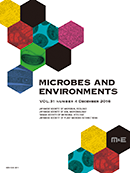33 巻, 3 号
選択された号の論文の15件中1~15を表示しています
- |<
- <
- 1
- >
- >|
Research Highlight
-
原稿種別: Research Highlight
2018 年 33 巻 3 号 p. 239-241
発行日: 2018年
公開日: 2018/09/29
PDF形式でダウンロード (271K) HTML形式で全画面表示
Regular Papers
-
原稿種別: Regular Papers
2018 年 33 巻 3 号 p. 242-248
発行日: 2018年
公開日: 2018/09/29
[早期公開] 公開日: 2018/09/13PDF形式でダウンロード (456K) HTML形式で全画面表示 -
原稿種別: Regular Papers
2018 年 33 巻 3 号 p. 249-256
発行日: 2018年
公開日: 2018/09/29
[早期公開] 公開日: 2018/07/25PDF形式でダウンロード (1578K) HTML形式で全画面表示 -
原稿種別: Regular Papers
2018 年 33 巻 3 号 p. 257-263
発行日: 2018年
公開日: 2018/09/29
[早期公開] 公開日: 2018/08/18PDF形式でダウンロード (1504K) HTML形式で全画面表示 -
原稿種別: Regular Papers
2018 年 33 巻 3 号 p. 264-271
発行日: 2018年
公開日: 2018/09/29
[早期公開] 公開日: 2018/08/09PDF形式でダウンロード (758K) HTML形式で全画面表示 -
原稿種別: Regular Papers
2018 年 33 巻 3 号 p. 272-281
発行日: 2018年
公開日: 2018/09/29
[早期公開] 公開日: 2018/08/07PDF形式でダウンロード (948K) HTML形式で全画面表示 -
原稿種別: Regular Papers
2018 年 33 巻 3 号 p. 282-289
発行日: 2018年
公開日: 2018/09/29
[早期公開] 公開日: 2018/09/08PDF形式でダウンロード (923K) HTML形式で全画面表示 -
原稿種別: Regular Papers
2018 年 33 巻 3 号 p. 290-300
発行日: 2018年
公開日: 2018/09/29
[早期公開] 公開日: 2018/08/24PDF形式でダウンロード (1827K) HTML形式で全画面表示 -
原稿種別: Regular Papers
2018 年 33 巻 3 号 p. 301-308
発行日: 2018年
公開日: 2018/09/29
[早期公開] 公開日: 2018/08/29PDF形式でダウンロード (739K) HTML形式で全画面表示 -
原稿種別: Regular Papers
2018 年 33 巻 3 号 p. 309-316
発行日: 2018年
公開日: 2018/09/29
[早期公開] 公開日: 2018/09/06PDF形式でダウンロード (1039K) HTML形式で全画面表示 -
原稿種別: Regular Papers
2018 年 33 巻 3 号 p. 317-325
発行日: 2018年
公開日: 2018/09/29
[早期公開] 公開日: 2018/09/12PDF形式でダウンロード (1134K) HTML形式で全画面表示
Short Communications
-
原稿種別: Short Communication
2018 年 33 巻 3 号 p. 326-331
発行日: 2018年
公開日: 2018/09/29
[早期公開] 公開日: 2018/08/29PDF形式でダウンロード (765K) HTML形式で全画面表示 -
原稿種別: Short communication
2018 年 33 巻 3 号 p. 332-335
発行日: 2018年
公開日: 2018/09/29
[早期公開] 公開日: 2018/08/28PDF形式でダウンロード (671K) HTML形式で全画面表示 -
原稿種別: Short communication
2018 年 33 巻 3 号 p. 336-339
発行日: 2018年
公開日: 2018/09/29
[早期公開] 公開日: 2018/08/24PDF形式でダウンロード (487K) HTML形式で全画面表示 -
原稿種別: Short communication
2018 年 33 巻 3 号 p. 340-344
発行日: 2018年
公開日: 2018/09/29
[早期公開] 公開日: 2018/08/24PDF形式でダウンロード (983K) HTML形式で全画面表示
- |<
- <
- 1
- >
- >|
